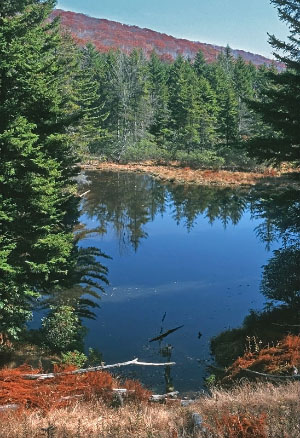
 Departamento de Conservación y Recreación (DCR)
Departamento de Conservación y Recreación (DCR) Conservar. Proteger. Disfrutar.
 Departamento de Conservación y Recreación (DCR)
Departamento de Conservación y Recreación (DCR)  Tabla de contenidos
Tabla de contenidosBosques de abetos y abetos
Las comunidades de este grupo se caracterizan por bosques de coníferas y mixtos con dominancia en el sotobosque por el abeto rojo (Picea rubens) o el abeto de Fraser (Abies fraseri). Bosques similares se encuentran en los Apalaches desde el sur de Virginia Occidental hasta el oeste de Carolina del Norte y el este de Tennessee.
Fraser fir forests reach their northern range limit in southwestern Virginia, where they are confined to elevations above 1,700 m (5,400 ft) on Mount Rogers in Grayson and Smyth Counties. Habitats are characterized by extremely acidic, organic-rich soils; cold microclimates; high rainfall; frequent fogs; and lush bryophyte cover. Understory layers are sparse, while mountain wood fern (Dryopteris campyloptera) and mountain wood-sorrel (Oxalis montana) dominate a relatively dense herb layer. Near the lower elevation limits, mixtures of Fraser fir and red spruce are characteristic. Fraser fir-dominated vegetation is seriously threatened by air pollution and destruction of fir stands by the balsam woolly adelgid (Adelges piceae), an introduced insect pest.
Red spruce (Picea rubens) forests similar in composition to those of the North Carolina and Tennessee high mountains are restricted to high-elevation slopes and summits of the Southern Blue Ridge (> 1,300 m [4,300 ft]) in Grayson, Smyth, and Washington Counties and Clinch Mountain (> 1,400 m [4,600 ft]) in Russell and Tazewell Counties. Environmental conditions are similar to those of the Fraser fir forests. Southern mountain-cranberry (Vaccinium erythrocarpum) and hobblebush (Viburnum lantanoides) are prevalent shrubs in the typical stands of these communities. A rarer community type features overwhelming shrub dominance by evergreen rhododendrons (Rhododendron maximum and Rhododendron catawbiense). Yellow blue-bead lily (Clintonia borealis), mountain wood fern (Dryopteris campyloptera), mountain wood-sorrel (Oxalis montana), shining clubmoss (Huperzia lucidula), and Canada mayflower (Maianthemum canadense) are abundant herbs rooting in the thick moss cover. As lower elevation limits are approached, co-dominance by hardwoods, particularly yellow birch (Betula alleghaniensis), increases.
Red spruce forests and spruce-hardwood mixtures also occur locally at high elevations of Allegheny Mountain (above 1,100 m [3,600 ft]) and Jack Mountain (above 1,280 m [4,200 ft]) in Highland County, but differ considerably from the Southern Blue Ridge and Clinch Mountain stands. At least two compositional variants, associated with submesic ridge crests and mesic stream-head valleys, are present on Allegheny Mountain. Distinctly southern species are nearly lacking from these forests, while northern species such as late lowbush blueberry (Vaccinium angustifolium), stiff ground-pine (Spinulum annotinum), prickly tree-clubmoss (Dendrolycopodium dendroideum), and staghorn clubmoss (Lycopodium clavatum), are abundant.

Debido a sus restringidos rangos geográficos y de elevación, todos los tipos de comunidades de este grupo ecológico se consideran raras a nivel mundial. Los bosques de abeto rojo proporcionan los únicos hábitats viables de Virginia para la ardilla voladora del norte (Glaucomys sabrinus fuscus), una especie en peligro de extinción incluida en la lista federal y estatal. Otros animales de importancia mundial o estatal asociados con los bosques de abetos y abetos incluyen la salamandra pigmea (Desmognathus wrighti), la salamandra de Weller (Plethodon welleri) y la liebre con raquetas de nieve (Lepus americanus virginianus), en peligro de extinción en el estado. Varias aves del norte, como el búho de sierra del norte (Aegolius acadicus), el zorzal ermitaño (Catharus guttatus), la curruca magnolia (Setophaga magnolia), el reyezuelo de corona dorada (Regulus satrapa), el trepador de pecho rojo (Sitta canadensis) y el chochín de invierno (Troglodytes troglodytes), dependen de los bosques de coníferas de gran altitud para reproducirse en Virginia.
Referencias: Adams (1991), Bailey y Ware (1990), Fleming y Coulling (2001), Fleming y Moorhead (1996), McLaughlin et al. (1987), Pielke (1981), Rawinski et al. (1994), Rheinhardt y Ware (1984), Smith y Nicholas (1999), Stephenson y Adams (1984), Stevens (1969).
Haga clic aquí para ver más fotos de este grupo comunitario ecológico.
 © DCR-DNH, Gary P. Fleming.
© DCR-DNH, Gary P. Fleming.

 Descargue una hoja de cálculo de estadísticas de resumen de composición para cada uno de los tipos de comunidad que se enumeran a continuación.
Descargue una hoja de cálculo de estadísticas de resumen de composición para cada uno de los tipos de comunidad que se enumeran a continuación.

